Christmas food in Japan, just like the holiday itself, is quite unique, with the occasion marked in its own distinct Japanese way.
Unlike in many countries, where Christmas is about large, home-cooked meals that have often been planned out over several shopping trips and multiple to-do lists, with special recipes and trimmings reserved only for this festive time of year, Christmas food in Japan is mostly store-bought and, not only that, fast food chains reign supreme.
In this post, we’ll discuss exactly what the Japanese order for Christmas and want constitutes Christmas food in Japan.
Table of Contents
When and how is Christmas celebrated in Japan?
Before we get to the food, we should briefly talk about how the holiday is celebrated here. Firstly, when Japanese people talk about Christmas, they are almost exclusively talking about December 24th (Christmas Eve). Neither December 24th nor 25th are public holidays in Japan, so festivities usually take place in the evening of the 24th after work and school.
Christmas in Japan is largely considered a date night for couples (an early Valentine’s Day, if you will) and usually comprises of going out to dinner and visiting a date spot (typically “winter illuminations” or seasonal light displays). Groups of friends are increasingly celebrating together too (sometimes doing a Secret Santa gift exchange), and families with children will usually spend the evening at home with takeout or Western-influenced food and the kids opening their gifts from Santa.
Since December 25th is business as usual and often falls on a weekday, these Christmas Eve get-togethers are usually done by about 9 or 10pm so everyone can get ready to go to the office or school the next day. In fact, it’s common to see Christmas displays being pulled down on the morning of the 25th and replaced with New Year decorations.
While Christmas doesn’t hold anywhere near as much importance as the New Year in Japan, it does have its own take on Christmas traditions, the center of which is food. So just what do the Japanese eat on Christmas?

Fried or roast chicken
As turkey is difficult to find in Japan, the staple dish for Christmas in Japan is chicken. Many restaurants offer special limited-edition Christmas chicken menu items for eat-in or takeout. This is usually fried or roast chicken, and may contain sides as well. One example is potato salad, which is believed to be an import from German Christmas cuisine.
Interestingly, one of the most popular places to get your fill of Christmas Eve chicken is at KFC. In fact, we can probably say that it is thanks to KFC that the whole chicken on Christmas Eve tradition became popular in Japan in the first place.
The popularization of KFC for Christmas in Japan came about as a result of a very successful marketing campaign in the 1970s, the roots of which can actually be traced back to an expat who went to the Aoyama store in Tokyo one Christmas and ordered such a large amount of chicken that he felt the need to explain to the store clerk that he was having a Christmas party and since he couldn’t find any turkey, he’d decided to just get a whole stack of KFC chicken instead.
The store manager picked up on this and was savvy enough to take the idea of promoting KFC for Christmas to the higher management. In 1974, they launched a campaign called “Kentucky for Christmas” (クリスマスはケンタッキー) that went so well it sparked a new tradition.
Nowadays, KFCs in busy locations can have queues around the block on Christmas Eve, with waiting times of several hours. While stores stock up big on chicken for the evening, they can and do sell out. That’s why they recommend placing an order in advance, either online or in-store. Doing so means that your order is guaranteed and you can use a special express queue when you pick it up.
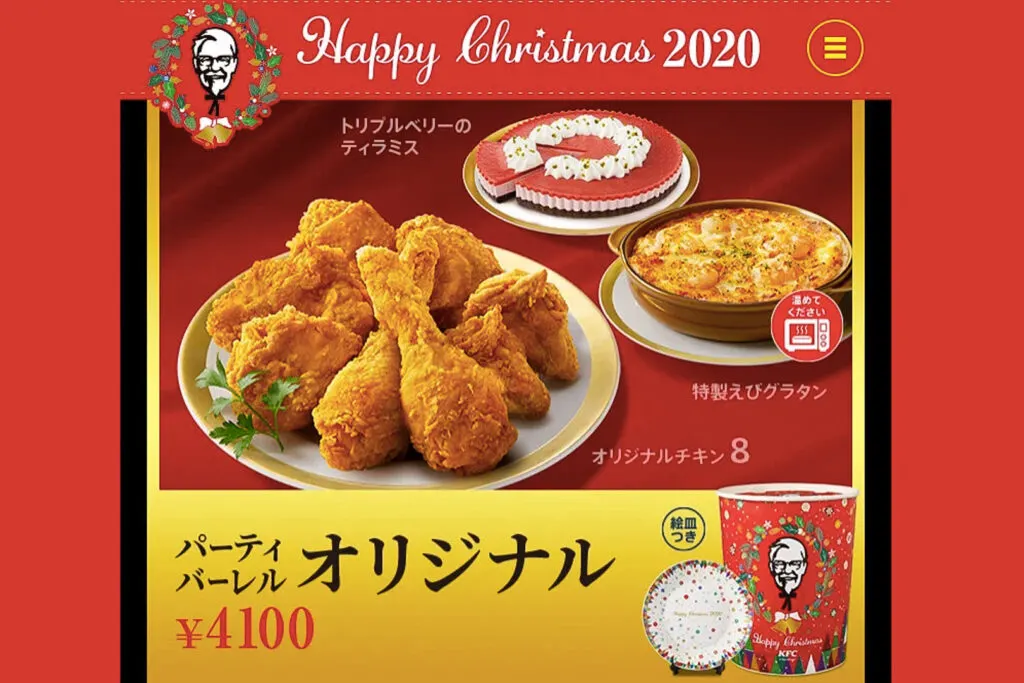
Pizza
With KFC taking the lion’s share of the limelight during Japan’s Christmas celebrations, it was only a matter of time before other fast-food outlets tried to get in on the increasing popularity of the holiday.
Over recent years, it has been Japan’s pizza industry that has been working hard to promote pizza as an alternative Japanese Christmas dinner. This hasn’t, however, been a difficult feat as pizza is already equated with party food in Japan, so it’s a natural fit for gatherings and celebrations.
Pizza Hut, Pizza-La and Domino’s all have Christmas and winter specials with toppings that supposedly capture the spirit of the season, like roast chicken and vegetables, roast beef, and fancied up versions of more traditional toppings such as camembert cheese and truffles. The trend is to offer “quattro” pizzas for Christmas, meaning each quarter of the pizza is a different flavor and topping combination.
Many pizza places offer additional seasonal chicken dishes not usually on the menu to satiate the Japanese consumer’s predisposition for chicken over Christmas, and Pizza Hut have in the past even made the wise move of teaming up with KFC to offer a Christmas combo pack of their pizza plus KFC chicken. How they coordinated those orders, I don’t know!
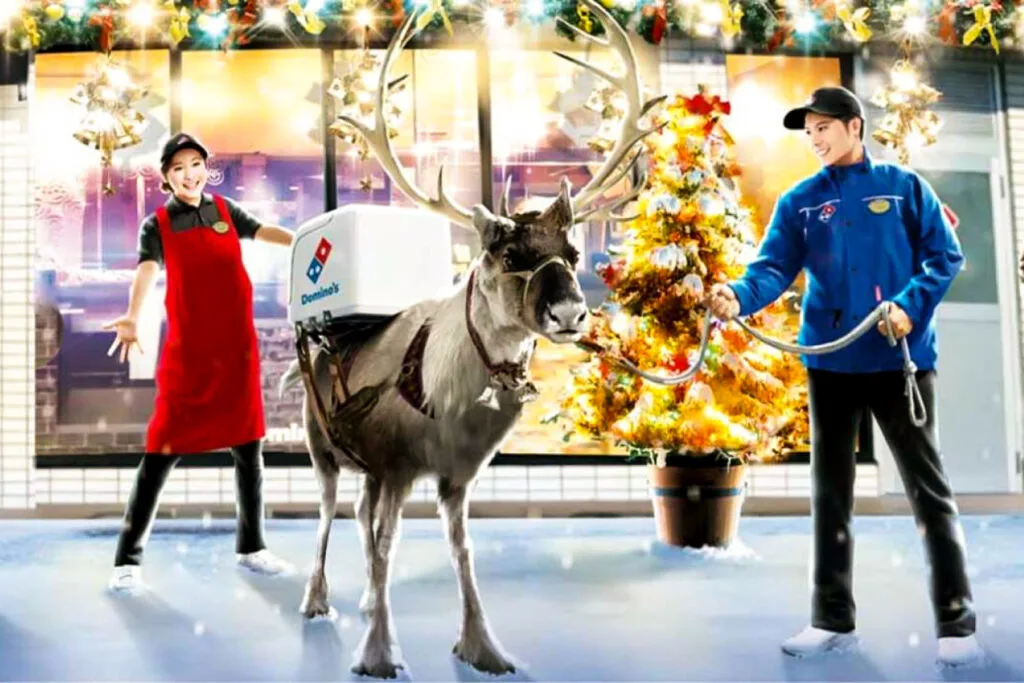
Domino’s Japan made headlines in 2016 when they attempted to train reindeer to deliver their Christmas orders by way of a GPS tracking app and self-driving sleighs in the northern, snowy prefecture of Hokkaido. Needless to say that the reindeer in training didn’t stick to their intended routes and the pizzas got upturned. They abandoned the idea a week later stating that the reindeer would be too difficult to control and instead dressed up their delivery scooters in reindeer garb instead.
One thing that is for sure is that pizza for Christmas has become extremely popular, with many pizza outlets struggling to keep up with Christmas Eve orders. You may be shocked to learn, however, that pizza in Japan is not the inexpensive meal it is in many countries. Expect one of these large festive pizzas to set you back about US$50.
Christmas Cake
The most popular Christmas food in Japan when it comes to dessert is simply referred to as “Christmas Cake”. In Japanese, it’s pronounced “kurismasu kei-ki” (クリスマスケーキ) and is essentially the ubiquitous strawberry shortcake, a dessert you’ll find in just about every cake shop or depachika in Japan, dressed up for the season.
It’s a round layered sponge cake with cream and strawberries, often with some kind of festive decoration like holly sprigs or confectionary in the shape of Santa or other Christmas motifs.
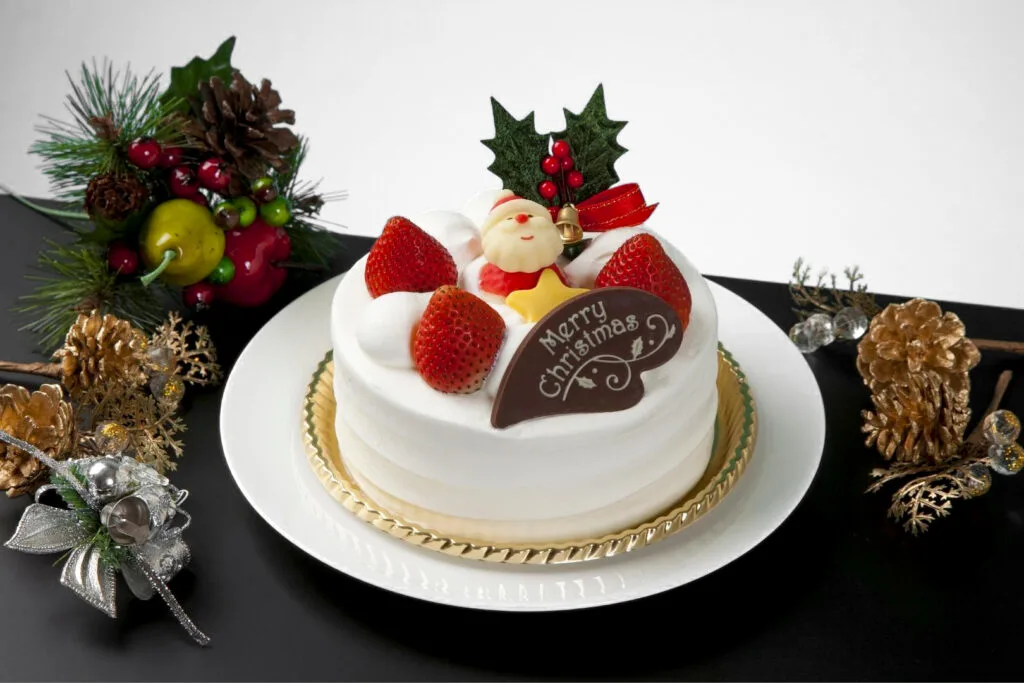
This kind of Western-style dessert only started gaining traction after WWII when ingredients like sugar and butter became more accessible, along with advancements in preserving fresh food items like cream and strawberries through refrigeration technology. As these ingredients were highly-prized, such desserts became symbolic of economic advancement in the post-war years and beyond. The red and white color palette is also culturally appealing, as these colors are auspicious in Japan and used for times of celebration.
Thanks to emoji being a Japanese invention, you’ll likely have seen and used the slice of cake emoticon that depicts this very dessert!
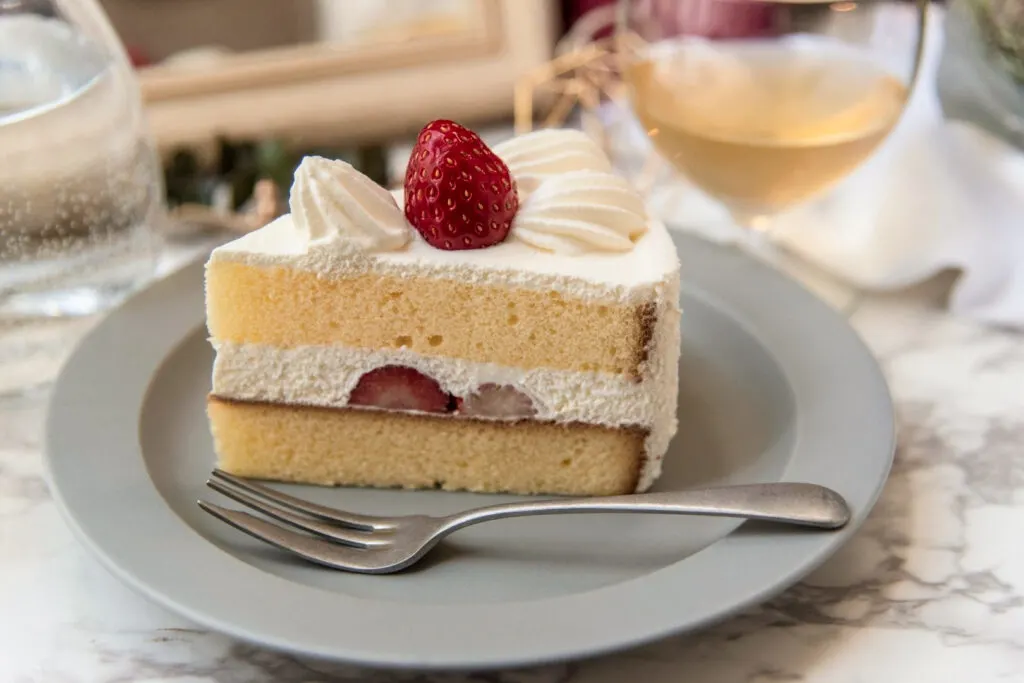
While the Christmas Cake is still the most representative Japanese Christmas dessert, nowadays there are a range of sweets marketed for the holiday, including chocolate cakes, cheesecakes, traditional European desserts like German stollen, Italian panettone, and the French bûche de Noël, as well as traditional Japanese desserts (wagashi) made along seasonal themes.
Most restaurants and fast-food outlets will offer desserts as part of their Christmas combo packages, so you can essentially order your entire Christmas meal in Japan from the one menu. I don’t know about you, but in the usual chaos of making a home-cooked Christmas dinner as is typical in some countries and cultures, the idea of just placing an order and picking it up on the night-of or having it delivered to your door, sounds like a stress-free approach to the holiday if you ask me.
There is, however, an unfortunate slang use of the term “Christmas Cake” in Japan. Just as an unsold Christmas cake on December 25th is considered past its use-by-date and to be thrown away, it is used as a derogatory way to refer to women who are over twenty-five and unmarried.
German Christmas Market Fare
An interesting trend over the past decade or so has been the adoption of the German-style Christmas market.
When you think of Christmas food in Japan, you probably don’t think German cuisine, but in the few weeks leading up to Christmas the Japanese celebrate the season with wooden market stalls selling typical German Christmas fare and trinkets.
Here you’ll find bratwurst and hot mulled wine as standard, and sometimes stollen and other treats. Expect to pay regular Japanese event prices, but if you’re after a Christmas-y atmosphere and a taste of something you can’t generally get the rest of the year, it hits the spot.
My top pick for a German Christmas market that is actually very true to Christmas markets you find in Germany is ‘Tokyo Christmas Market‘ held at Hibiya Park, Tokyo (and now Shinjuku Odakyu Park as well). Each year, you can get an original Glühwein mug to take home as a souvenir, just as they have in Germany.
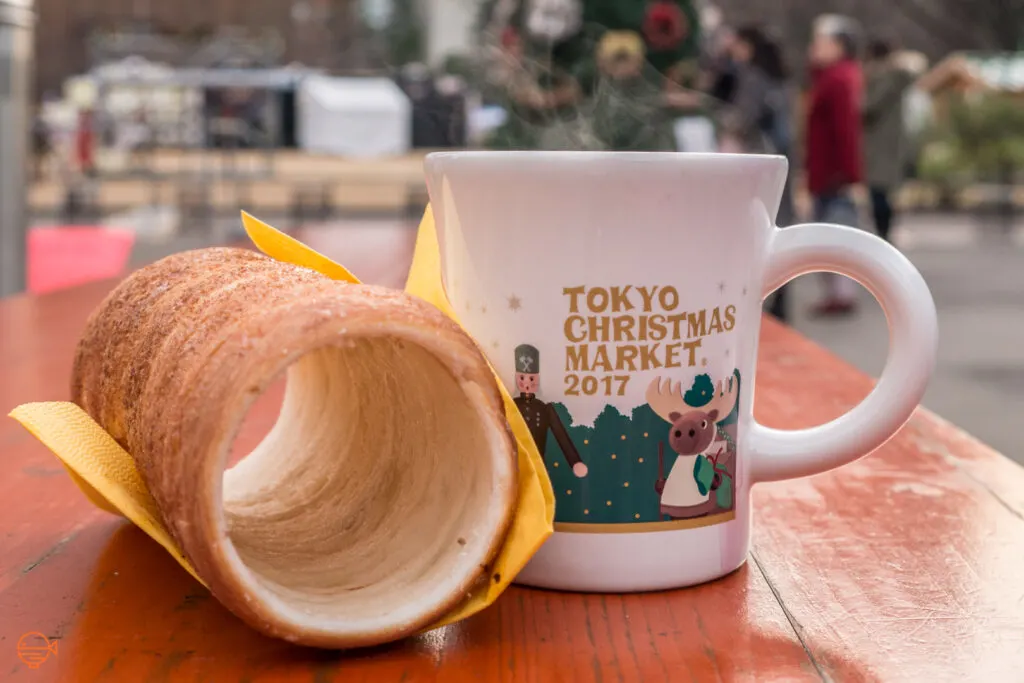
Tokyo Christmas Market along with the other popular German-style Christmas Markets in Tokyo are held until December 25th, perfect for those looking for some festive cheer on Christmas Day itself!
Tip: German Christmas Markets can get extremely busy, especially on New Year’s Eve. To avoid the crowds, visit at an earlier date if possible and/or during the day.
Chanmery
If you’re looking for a non-alcoholic drink for your Christmas celebrations, Japan has got you covered. Enter Chanmery, a combination of the words “Champagne” and “Merry Christmas”.
Chanmery (シャンメリー) is a carbonated soft drink with a cap that sounds like a popping champagne cork when you open it. It’s widely regarded as a party drink for kids, allowing them to get in on the toasting fun. Because of this, you’ll often find Chanmery bottles with depictions of popular children’s characters on the packaging.
Interestingly though, it didn’t start out as a kids drink, but was served at hostess bars and clubs. As hostesses make money when customers buy them drinks, this champagne imitation allowed them to keep the party atmosphere going while staying sober. The drink was actually known at the time as “soft champagne” but after a complaint from the French Embassy to the Foreign Ministry, producers were asked to come up with a new name that didn’t use the word “Champagne”.
The drink had already become popular as a Christmas drink, so the name Chanmery was born. It can, however, be bought throughout the year as a party drink for any occasion, just afforded less shelf space. During the Christmas season, expect to find whole sections of the supermarket filled with Chanmery options.
When you peruse the shelves, there’s another interesting detail you may notice. You won’t see any of the usual major drink companies like Kirin, Suntory or Asahi because they actually aren’t allowed to manufacture Chanmery. This is due to a 1977 law that was passed to protect small manufacturers in certain sectors from being pushed out by big competition. These specific sectors include products like tofu, ramune and Chanmery.
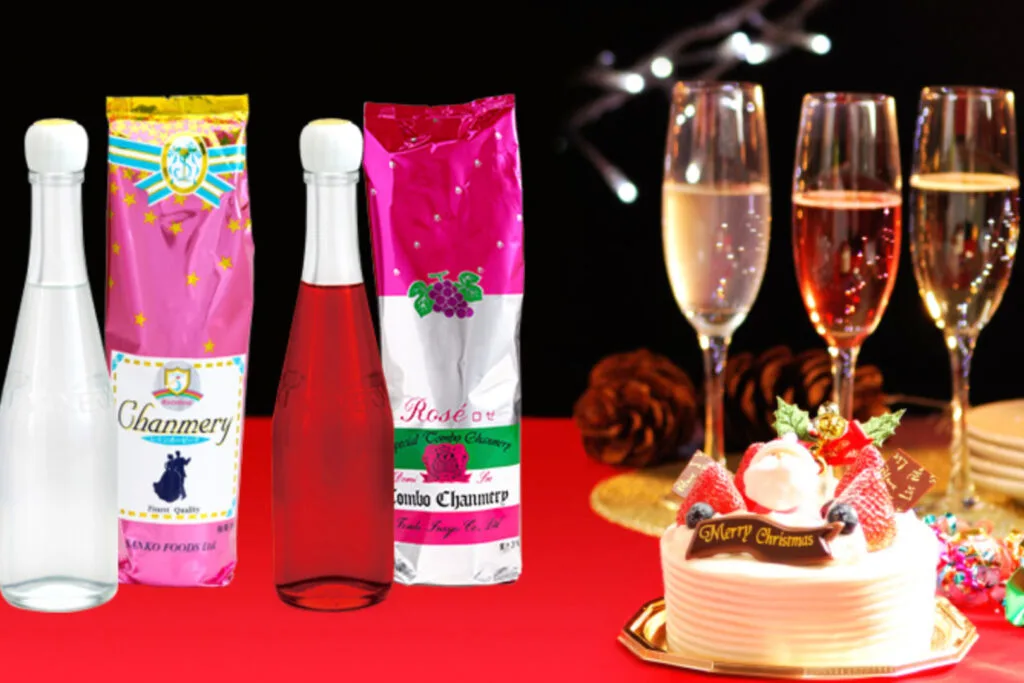
Tips for ordering Christmas food in Japan
Christmas food in Japan and the culture around it is evolving. It used to be that Christmas foods were only available until December 24th and not on Christmas Day itself.
I clearly remember my first Christmas in Japan and going out to try to buy one of the aforementioned chicken packs at a local restaurant on Christmas Day. They were perplexed why I would be asking when Christmas was “over” and I was wondering why on earth a Christmas special wouldn’t be until Christmas Day.
Nowadays, many places extend their Christmas offerings until December 25th, but always be sure to check this in advance (Christmas Eve really is the big hurrah) as well as the ordering procedure. Some establishments require you to pre-order by a certain cut-off date, while others may allow walk-ins on-the-day, but you will likely have to wait longer and it’s on a first-come-first-served basis. Remember that restaurants can and often do sell out at some point.
Major restaurants and fast-food outlets usually have an online pre-ordering system, so you can select what you want with a few clicks and have your order guaranteed. There is typically priority service given to those with advanced reservations. KFC, for example, has a separate queue for pre-orders which can significantly expedite your wait time.
In past years, pizza deliveries have been significantly delayed due to the incredible volume of orders on Christmas Eve, even when that order was placed in advance. While hopefully pizza chains have learned to compensate for this with added staff and being realistic about the number of orders they can accommodate, it’s wise to select a delivery/pick-up time earlier than you require to account for potential delays.
The best way to enjoy your order of Christmas food in Japan is to be organized by checking out the offerings at your preferred restaurant ahead of time, placing an advanced reservation by the cut-off date, and then having a relaxing, festive evening without the dishes.
What do you think about Christmas food in Japan? Do you like the restaurant bought tradition?
Pin me for later
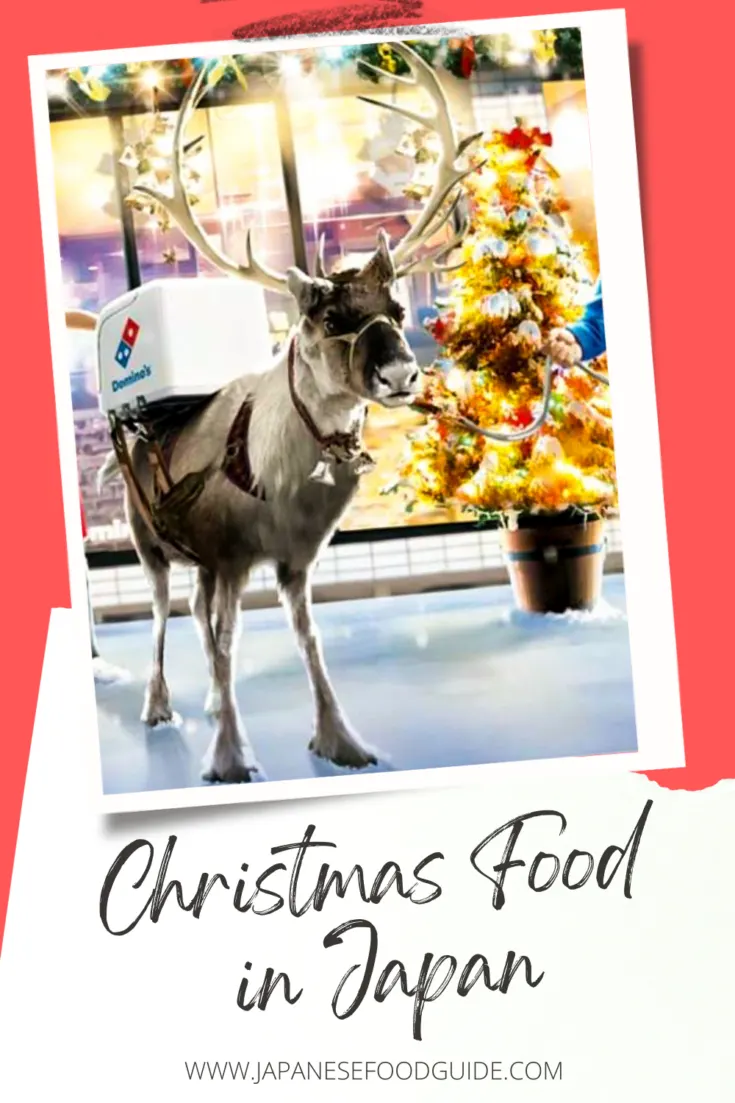
Jessica Korteman is a seasoned travel writer from Melbourne, Australia. She has spent a decade living, working and traveling in Japan, and specializes in Japanese culture, festivals and events, and travel destinations both on and off the beaten path throughout the country.
She is the Founder and Editor of Japanese Food Guide.

Kaori
Saturday 30th of October 2021
I remember being so confused as to why strawberry season in Tokyo was winter, when it was summer in Hokkaido (and everywhere else in the world...😂), but then I heard it was due to having to produce strawberries for Christmas cake! Made sense!
Loved the story about Domino Pizza. Would have loved to have seen that! Hehe.